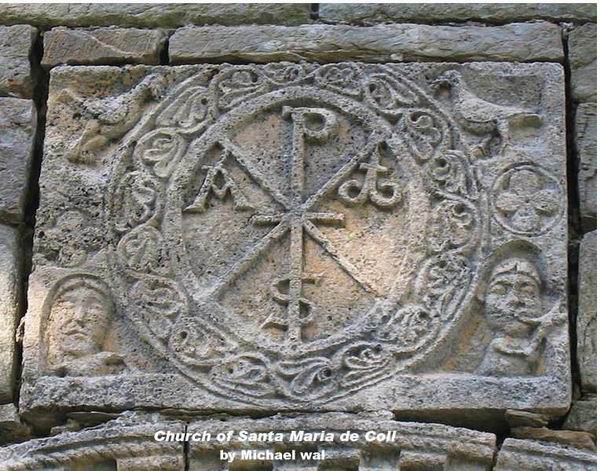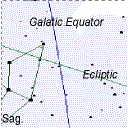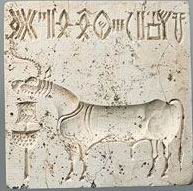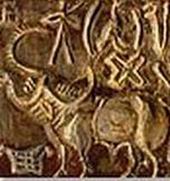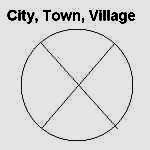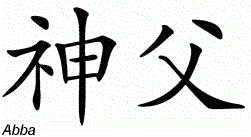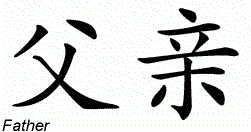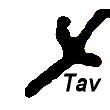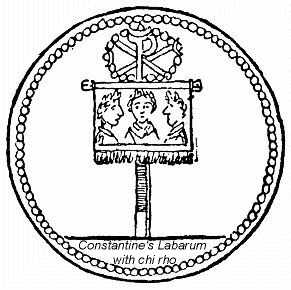|
|
The Lost Christian Symbol for Galactic Alignment
Right Before Our
Eyes By Steve Santini September 2010
There is a common symbol for galactic alignment present in this day. It is not the only or the most ancient historical symbol for galactic alignment. However, for almost one thousand years, it was the primary Christian symbol in the Western World for this time of judgment and resurrection. Most have seen it. Now, though, it goes unrecognized for its original meaning. That symbol is called the chi-rho symbol. It is a combination of the Greek letters X and P with X pronounced as a guttural khi and the P as the English r. The Greek spelling of the word Christ begins with these two Greek letters X and P. So, the symbol is also considered as a Christogram. Many of the letters of our alphabet were originally derived from celestial signs and/or celestial realities. For example the letter A was derived from the celestial sign of Taurus the bull of heaven. In the older Semitic alphabets this first letter was an ox head and was pronounced as aleph. For them it was appropriate to have the symbol of Taurus as the first letter of the alphabet. Easterners believed that the circle of the zodiac began in the Aires-Taurus border making Taurus the first sign of the zodiac. Taurus' horns, like the legs of the A, are directed left to right or clockwise as if it is moving forward around the zodiac like the planets, sun and moon. As a result, it may be that a number of ancient bull motifs represent the entire zodiac.
The letter chi was also derived from a celestial configuration. Theologian Hugo Rahner pointed out the crossing of what he assumed were the two great circles of the heavens as the origin of the letter chi in his book, Greek Myths and Christian Mystery. "The two great circles of the heavens, the equator and the ecliptic, which, by intersecting each other form a sort of recumbent chi and about which the whole dome of the starry heavens swings in a wondrous rhythm, became for the Christian eye a heavenly cross The crossing of the celestial equator and the ecliptic in the asterism of Awwa within Virgo is an important celestial marker as is the other crossing of the two in Pisces. In 2 BC the Magi from the East followed Jupiter as it was making a triple conjunction with this crossing in Virgo before sunrise as they traveled west to honor the young child Jesus-the promised Savior. However, because of its striking appearance and universal significance, it is more likely that the letter chi was derived from the intersection of the galactic equator and the ecliptic. In addition, the angular separation of the two legs of the proposed chi origins by Hugo Rahner is slight while the angular separation of the two legs of the chi from the intersection of the ecliptic and the galactic equator appears much more like that of an X.Frances Rolleston's 19th century book, The Mazzaroth, documents that Sagittarius, beside the crossing of the ecliptic and the galactic equator, was originally represented by the Hebrew letter chi.
This symbol of an X representing the golden gate as the opening in heaven for the gods is found in the most ancient scripts and motifs. The Indus Valley script of the third and second millennia BC combined the bull of heaven motif with that of the X symbol in their unique clay seals.
The Egyptians and the Indus Valley civilizations both used the X symbol inside a circle to represent towns. For the Egyptians the circle was a representation of Ra, their sun god. The two legs of the X represented streets or roads intersecting at a central point. In antiquity the temple to the patron god was the center of each city. Both the galaxy and the ecliptic were considered roads. The galaxy was considered as the way of the gods while the circle of the zodiac or ecliptic represented the path or way of the soul. The intersection of the two legs of the X was the meeting point of the gods and the souls of men symbolically, as was also the case with the city's central temple.
The Elamite's who were contemporary eastern neighbors of the Sumerians designated their central deity, the bull god Insusinak, with a double X.
Enki, a primary god of the Sumerians, appeared in relief with a solar disc engraved with an X on his left ankle. In the Epic of Atrahasis, Enki was the god who saved mankind from the deluge. He was the senior god of the assembly of the gods. Enki played the presiding role in the deluge of the epic of Gilgamesh. His home of Eridu was said to have been the first city built after the deluge. The celestial symbol of Eridu was the bright star Nunki in Sagittarius, which lies just east of the Golden Gate of Heaven. Enki himself was know as the god of the southern constellations that surround the Golden Gate of Heaven. Notice the ki phoneme in both the words Enki and Nunki. In Sumerian the en phoneme means Lord making Enki the Lord of ki
In the Sumerian cuneiform the X symbol holds a unique position. It is not considered a letter but is used distinctly in only one of their words. It is placed in the middle of the two Sumerian letters ki and ta as ki-X-ta. It means disbursed by X or from the place of X. (Sumerian Lexicon, JA Holloran) Much later, the Chinese had relations with the eastern cultures by way of the ocean and land routes from the Middle East. Archeological discoveries of figurines marked by crosses in the 8th century BC imperial palace of the Zhou Dynasty tell of the presence of Eastern Magi in their court. These were members of the original priestly line of Japheth descended from Noah's great grandson Magi according to Herodotus. (And it was in their country of Media that white stallions were bred so that one day one would be ready for the Messiah of all people to ride upon.) Older Chinese symbols contain the symbolic X in some of their words. These words include righteousness, holy, winter, abba and father. Abba Father was a term the apostle Paul used in his 1st century writings. Abba is said to be a term of endearment. It also implies the way to the hidden sacred source.
Even later, in
the 8th century AD, the Mesoamerican Maya named the Milky Way's dark
area, that they considered as a rift obscuring the galactic center, Xibalba. It was they, who descended from the Olmec
who left their carved heads indicating South East Asian origins and it was
they, the Maya, whom in most distinct writings, looked forward to the day that
the symbol of the chi-rho would become manifest as their vision of a new
world reality. In developing Europe during the 9th century BC the Greeks adopted and adapted the Eastern Semitic alphabet. By such it became the first European alphabet. At first it did not contain the letter X that they named chi. By the 6th century BC the chi had been incorporated into their alphabet. Solomon Reinach, the 19th century epigraphic scientist, proposed that the chi had been a derivation of the Semitic tav. The Tav was the final letter of the Semitic alphabet. It appears as a t lying on its side and as such looks similar to the X. It means a sign, a signature and a mark as in the current idiom X marks the spot on the map for the treasure's location
The Greeks were aware that the letter chi represented the crossing of the ecliptic and the galactic equator. Plato, the philosopher, as had Solon, one of the founding Greek sages, spent 13 years among the priest of Ra in Heliopolis. Cross-cultural similarities and records[i] also indicate that the Eastern Magi from Media also had, from time to time, been present among the priest of Ra. Plato, after his time in Heliopolis, returned to Greece and established the first academy in the West. In 360 BC he wrote the Dialogue of Timaeus. In the dialogue, Timaeus describes the world soul as two lines crossing like a chi then extended the lines to form two intersecting circles just as the ecliptic and galactic equator are two intersecting circles. The second
letter of the chi-rho symbol is the r phoneme written as the Greek P. In the earliest Semitic alphabets the
r sound was depicted a head turned to the left. It evolved into a P turned left. It was used in the Egyptian
cursive hieratic script in the transliteration of the solar disc hieroglyph for
Ra, the sun god. Later the P was turned to the right in the Greek
alphabet. Since the time that the word Ra
and the Sumerian word hara
meaning blazing were introduced,
languages for millennia have used the r phoneme
to denote things associated with the sun. Today the English language has such
words as ray, radiant, rainbow, aurora,
orbit, rise, horizon and others seemingly a bit more distant like realm, reign, regal, Pharaoh and Cyrus, with the Cy being pronounced as the ki phoneme in Old Persian. Some biblical Greek words that begin with chi and include rho are enlightening in regards to this Christogram being a symbol for the sun's presence at the crossing of the galactic equator and the ecliptic on the winter solstice. The words include Christ, grace, time, abounded place, winter torrent, a mark, a circular rampart, a gulf or rift, cherubim, golden, lacking a husband, a circular wedding dance, admonished of a god, a courtyard filled with sustenance, anoint, appoint for office, a spiritual endowment, kindness and a revelation. In the 3rd century BC, Euergetes, the Macedonian Ptolemaic ruler of Egypt ingratiated himself to all religions through his munificence. During his reign he had bronze coins minted for common daily transactions with the chi-rho symbol.[ii] In the 2nd and 3rd centuries Greek scribes used the letters X and P to mark passages they considered noteworthy. Then, in 312 AD, the Roman Caesar, Constantine, superimposed the P on the X as the result of his apparent heavenly vision of the sun. He ordered the symbol to be inscribed on the amour and weapons of his soldiers in preparation for the crucial Battle of Milvian Bridge with Emperor Maxentius' predominately Eastern army. Constantine's forces won a resounding victory. In 313 AD the new Emperor Constantine issued the Edit of Milan that allowed toleration of the formerly persecuted Christians. In 317 AD Constantine made the chi-rho symbol a part of his military standard in what is called the labarum. In 325 AD the symbol began to appear on Constantine's coinage. Shortly before his death in 337 AD Constantine committed himself to Christianity.
In the following years the chi-rho symbol became an ecclesiastical symbol in the West representing the coming of the saints of Christ and the Lord Jesus Christ, himself, for the first resurrection and the successive judgments. The symbol began to be used extensively on sarcophagi and grave markings through the 12th century AD. After this time it seems to have lost its most fundamental meaning.
Today, the chi-rho symbol is still used as an ecclesiastical symbol on banners and in markings. Unfortunately, as with other ancient truths, its message seems just a faint whisper compared to its former voice.
A review of the 11th century AD chi-rho symbol in the structure of the church of Santa Maria de Coll restates the widely known, common truths established from the times of the earliest cultures. The two doves sent out by Noah from the ark are in the upper right and left. The dove on the right holds the olive branch in its beak confirming Noah's hope that dry land had been found. The alpha and omega, the first and last letter of the Greek alphabet representing the beginning and end flank the chi rho inside the victory wreath. The cross on which Jesus was crucified appears centrally in combination with the leg of the rho where the legs of the chi cross. The rho superimposed on the chi depicts the sun in the golden gate of heaven, or, in other words galactic alignment. The figure on the lower left holding the kid appears to represent a decan of the zodiacal constellation of Taurus; that is, the sign of Augira, The Shepard who stands above the silver gate of heaven. In the context it appears that the figure blowing the horn in the lower right is the angel who blows the trumpet for the first or better resurrection at the return of Jesus, the Christ, to reign on earth. Remove not the ancient landmark, which thy fathers have set. Proverbs 22:28 (Chi Rho Images: 1, 2, 3, 4, 5, 6) Related Article The Galactic Center and The Kingdom of God Commeth with Observation Previous Article The
Golden Gates on Earth and in Heaven Introduction and Main Index
Copyright,
Steven G. Santini, 2010
|
